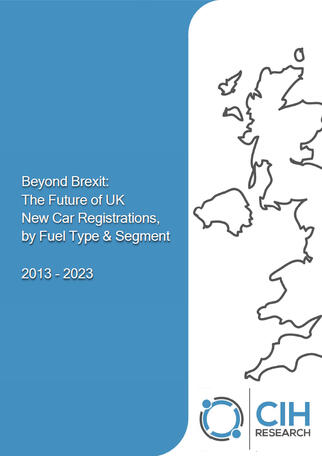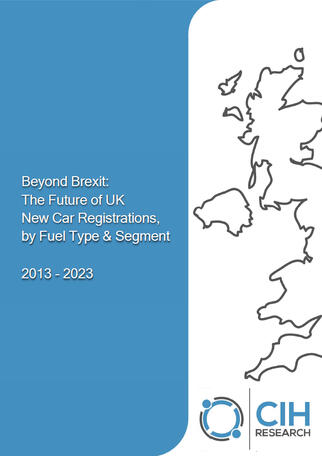
CIH Research is a UK-based market research consultancy firm offering quantitative expertise, and can provide full-service consultancy, to data-only services.
About
CIH Research Ltd can deliver custom projects, data and insights and has experience delivering projects for some of the biggest names in the Automotive OEM and OES sectors, including: Philips Automotive Lighting, Johnson Controls, PSA, SEAT, Mobis, Delphi and Continental.
ADVISORY SERVICES
CIH Research has also provided specialist advisory services for some of the biggest names in consultancy, including McKinsey & Company and others.
CAPABILITIES
CIH Research can provide a broad range of market research capabilities including:• Client needs mapping, questionnaire design & validation, face-to-face, telephone & panel interviewing, workshop moderation and secondary research capabilities;
• Market sizing, multi-variant forecast/modelling, trend reporting, competitive landscaping, competitor analysis, strategic and consumer insights;
• Data visualisation, dashboard design, copywriting, live & pre-recorded interviews, conference presentation, client delivery, tender presentation.
MEDIA APPEARANCES
CIH Research's senior consultants have been sought to share his opinion via a variety of business and industrial trade publications including: the Financial Times, Wall Street Journal and Automotive Industries. He has been sought to provide his opinion on global automotive events by CNBC, Bloomberg and Reuters and he has provided comment for publications such as Motortradenews, AMonline, Fleetworld and Fleet News, as well as a variety of national newspapers, regarding new car sales and issues affecting the automotive industry.
Accreditations



Interested in what we can do for you?Get in touch!
Contact
If you would like to know more about what services CIH research can provide your organisation, please get in touch by clicking on of the contact links, or via the form below.
PRODUCTS
Beyond Brexit: The Future of UK New Car Registrations by Fuel & Segment
United Kingdom: New Passenger Vehicle Registrations Database
Beyond Brexit: The Future of UK New Car Registrations by Fuel & Segment
United Kingdom: New Passenger Vehicle Registrations Database
To register your interest in gaining access to CIH Research Ltd UK New Car Registration Statistics and Database, please send a message to the sales team at CIH Research Ltd, or use the contact form provided here.
Beyond Brexit: The Future of UK New Car Registrations by Fuel & Segment
Why Should You Buy this Report?This report provides the reader with a comprehension of how the market has evolved since 2013 and will continue to evolve to 2023 by the following KPIs:
• Vehicle brand
• Vehicle model
• Vehicle segment
• Brand segment
• Fuel typeThis report provides quantitative insight and analysis on the volume and value of the UK new vehicle registrations market, and provides answers to questions such as:• What are the most popular cars, by segment, model and brand?
• Why are these vehicles so popular?
• Which brand has grown the fastest in terms of registrations volume since 2013?
• What is the current and future popularity of “crossovers”?
• Which brand has grown the fastest in terms of value, since 2013?
• What is the most valuable segment to be involved in in 2019 to 2023, and why?
• How many electric vehicles were registered, and by which manufacturer?
• How many hybrid vehicles were registered, and by which manufacturer?
• Which is the fastest growing vehicle segment in the UK, and why?
• Which vehicle segments will radically change by 2023, and why?
• Which segments will cease to exist as we know them by 2023, and why?
• What is the future of diesel-powered vehicle registrations, by brand?
• When will electric vehicles begin to gain major market share in registrations?
• When will hybrid vehicles begin to gain major market share in registrations?
• What is the UK car market forecast considering the impact of BREXIT?
Beyond Brexit: The Future of UK New Car Registrations by Fuel & Segment
To register your interest and for a sample copy of the Executive Summary, please send a message to the sales team at CIH Research Ltd, or use the contact form here.
Beyond Brexit: The Future of UK New Car Registrations by Fuel & Segment
Table of Contents
1. Introduction
1.1 Scope
1.2 Objective
1.3 Methodology
1.3.1 Volume Methodology
1.3.1.1 Vehicle Segmentation
1.3.2 Valuation Methodology
1.3.3 Forecast Methodology
1.4 Companies Mentioned
1.5 Geographic scope
1.6 Units and Measurement
2. About CIH Research Ltd
2.1 Expertise
2.2 Associated reports and analysis
2.3 Market Reports
2.4 Custom Insights
2.5 Database access
3. Executive Summary
3.1 Market Outlook
3.2 Cars and MPVs in decline
3.3 The rise of the SUV
3.4 The Market by Brand Segment
3.5 Manufacturer Rankings
3.6 The Future of the Market
4. UK PESTLE Analysis
4.1 Economic Overview
4.1.1 International Trade
4.1.2 GDP Growth
4.1.3 The Impact on Registrations of a Negative Economic Scenario
4.2 Political Overview
4.2.1 Brexit Review
4.2.2 Brexit with a Deal
4.2.3 No-deal Brexit
4.3 Social Overview
4.3.1 Changing Attitudes to Transportation
4.3.2 The Demography and Uptake of Driving Licenses
4.4 Legislation Overview
4.4.1 Emissions Testing
4.4.1.1 The introduction of WLTP
4.4.1.2 The Impact of WLTP
4.4.2 Emissions Reduction
4.4.2.1 Regulation (EC) 443/2009
4.4.2.2 How will it work?
4.4.2.3 What are the penalties?
4.4.2.4 What can manufacturers do?
4.4.2.5 What will be the outcome? 46
4.5 Environmental Overview
4.5.1 Road to Zero
4.5.2 The Dawn of Hybrid and Electric Vehicles?
4.6 Technological Overview
4.6.1 Regulatory frameworks on electricity distribution
5. Car Registrations & Segment Analysis
5.1 Overview
5.1.1 Historical Overview
5.1.2 Forecast Overview
5.2 A-Segment Analysis and Forecast
5.2.1 Historical Analysis
5.2.2 Forecast Analysis
5.2.3 Conclusions
5.3 B-Segment Analysis and Forecast
5.3.1 Historical Analysis
5.3.2 Forecast Analysis
5.3.3 Conclusions
5.4 C-Segment Analysis and Forecast
5.4.1 Historical Analysis
5.4.2 Forecast Analysis
5.4.3 Conclusions
5.5 D-Segment Analysis and Forecast
5.5.1 Historical Analysis
5.5.2 Forecast Analysis
5.5.3 Conclusions
5.6 E-Segment Analysis and Forecast
5.6.1 Historical Analysis
5.6.2 Forecast Analysis
5.6.3 Conclusions
5.7 F-Segment Analysis and Forecast
5.7.1 Historical Analysis
5.7.2 Forecast Analysis
5.7.3 Conclusions
5.8 Car Segment Conclusions
6. SUV Registrations & Segment Analysis
6.1 Overview
6.1.1 Historical Overview
6.1.2 Forecast Overview
6.2 JA-Segment Analysis and Forecast
6.2.1 Historical Analysis
6.2.2 Forecast Analysis
6.2.3 Conclusions
6.3 JB-Segment Analysis and Forecast
6.3.1 Historical Analysis
6.3.2 Forecast Analysis
6.3.3 Conclusions
6.4 JC-Segment Analysis and Forecast
6.4.1 Historical Analysis
6.4.2 Forecast Analysis
6.4.3 Conclusions
6.5 JD-Segment Analysis and Forecast
6.5.1 Historical Analysis
6.5.2 Forecast Analysis
6.5.3 Conclusions
6.6 JE-Segment Analysis and Forecast
6.6.1 Historical Analysis
6.6.2 Forecast Analysis
6.6.3 Conclusions
6.7 JF-Segment Analysis and Forecast
6.7.1 Historical Analysis
6.7.2 Forecast Analysis
6.7.3 Conclusions
6.8 SUV Segment Conclusions
7. MPV Registrations & Segment Analysis
7.1 Overview
7.1.1 Historical Overview
7.1.2 Forecast Overview
7.2 MB-Segment Analysis and Forecast
7.2.1 Historical Analysis
7.2.2 Forecast Analysis
7.2.3 Conclusions
7.3 MC-Segment Analysis and Forecast
7.3.1 Historical Analysis
7.3.2 Forecast Analysis
7.3.3 Conclusions
7.4 MD-Segment Analysis and Forecast
7.4.1 Historical Analysis
7.4.2 Forecast Analysis
7.4.3 Conclusions
7.5 ME-Segment Analysis and Forecast
7.5.1 Historical Analysis
7.5.2 Forecast Analysis
7.5.3 Conclusions
7.6 MF-Segment Analysis and Forecast
7.6.1 Historical Analysis
7.6.2 Forecast Analysis
7.6.3 Conclusions
7.7 MPV Segment Conclusions
8. Sports Registrations & Segment Analysis
8.1 Overview
8.1.1 Historical Overview
8.1.2 Forecast Overview
8.2 SB-Segment Analysis and Forecast
8.2.1 Historical Analysis
8.2.2 Forecast Analysis
8.2.3 Conclusions
8.3 SC-Segment Analysis and Forecast
8.3.1 Historical Analysis
8.3.2 Forecast Analysis
8.3.3 Conclusions
8.4 SD-Segment Analysis and Forecast
8.4.1 Historical Analysis
8.4.2 Forecast Analysis
8.4.3 Conclusions
8.5 SE-Segment Analysis and Forecast
8.5.1 Historical Analysis
8.5.2 Forecast Analysis
8.5.3 Conclusions
8.6 SF-Segment Analysis and Forecast
8.6.1 Historical Analysis
8.6.2 Forecast Analysis
8.6.3 Conclusions
8.7 Sports Segment Conclusions
9. Registrations Analysis by Fuel type
9.1 Overview
9.1.1 The decline of diesel:
9.1.2 Petrol Vehicle Registrations & Analysis
9.1.3 Petrol Vehicle Registrations Forecast
9.1.4 Conclusions
9.2 Diesel Vehicle Registrations & Analysis
9.2.1 Diesel Vehicle Registrations Forecast
9.2.2 Conclusions
9.3 Hybrid and Alternatively-Fuelled Vehicle Registrations & Analysis
9.3.1 Hybrid Vehicle Registrations Forecast
9.3.2 Conclusions
9.4 Battery Electric Registrations & Analysis
9.4.1 Battery Electric Registrations Forecast
9.4.2 Conclusions
10. Glossary
10.1 Abbreviations
10.2 Definitions
11. References
Beyond Brexit: The Future of UK New Car Registrations by Fuel & Segment
Table of Figures
Figure 1: Table of Manufacturers mentioned and Included in the Report
Figure 2: The United Kingdom Registrations Market for New Passenger Vehicles, 2013 - 2023
Figure 3: The United Kingdom New Registrations Market for Passenger Vehicles, by Segment, 2018 (%)
Figure 4: Growth in SUV Registrations versus Decline in MPV Registrations (2013 – 2018)
Figure 5: The United Kingdom New Registrations Market for Passenger Vehicles, by Brand Segment, by Volume 2018 (%)
Figure 6: The United Kingdom New Registrations Market for Passenger Vehicles, by Brand Segment, by Value 2018 (%)
Figure 7: The Top Ten Manufacturers by Volume of New Registrations in the United Kingdom, 2013 – 2018
Figure 8: The Top Ten Manufacturers by Value of New Registrations in the United Kingdom, 2013 – 2018
Figure 9: UK, GDP composition by sector, 2017
Figure 10: UK major export partners, 2017
Figure 11: UK major import partners, 2017
Figure 12: UK, Real GDP Growth, 2013 - 2023
Figure 13: GBP to USD exchange rate, 2013 - 2018
Figure 14: Overall UK Global Exports, 2014 – 2018
Figure 15: OECD Composite Leading Indicator (CLI) Index, 2013 - 2019
Figure 16: Real GDP in Brexit Scenario, 2015 - 2023
Figure 17: OECD Consumer Confidence Index (CCI), 2013 - 2019
Figure 18: An Overview of New Car Registrations (2013 – 2018)
Figure 19: New Car Registrations, split by Imports and Domestic Production (2013 – 2018)
Figure 20: UK Car Production, by Overall Market Destination (2008 – 2018)
Figure 21: UK Population Forecast, (2018 – 2030)
Figure 22: UK Employment by Generation (Q1 2019)
Figure 23: Full Car Driving License Holders, by Age, in England, (2007 to 2017)
Figure 24: De-seasonalised registrations performance, (2018 vs 2013-2018 Average)
Figure 25: Sector CO2 emissions as a share of UK total, 2016 (GHGs)
Figure 26: Forecast Electric Vehicles Registrations, by Type, 2018 – 2030
Figure 27: Forecast Electric Vehicles as a Percentage of Overall UK Car Parc (<3.5t), 2018 – 2030
Figure 28: Forecast Overall Growth in UK Charging Point Infrastructure (2019 – 2030)
Figure 29: An Overview of All New Passenger Vehicle Registrations, by Segment (2013 – 2018)
Figure 30: An Overview of New Car Registrations, by Brand Segment (2013 – 2018)
Figure 31: Top 5 Manufacturers, by Registration Volume (2013 – 2018)
Figure 32: BMW model count by Segment, 2013-2018
Figure 33: Top 5 Manufacturers by Registration Value (2013 – 2018)
Figure 34: An Overview of New Car Registrations, by Fuel Type and Volume (2013 – 2018)
Figure 35: An Overview of Forecast Car Registrations, by Volume (2019 – 2023)
Figure 36: An Overview of Forecast Car Registrations, by Fuel Type and Volume (2019 – 2023)
Figure 37: New A - Segment Car Registrations, by Volume (2013 – 2018)
Figure 38: A - Segment Registrations, by Fuel Type (2013 – 2018)
Figure 39: Forecast A - Segment Car Registrations, by Volume (2019 – 2023)
Figure 40: Forecast A - Segment Car Registrations, by Fuel Type and Volume (2019 – 2023)
Figure 41: New B - Segment Car Registrations, by Volume (2013 – 2018)
Figure 42: New B - Segment Registrations, by Fuel Type (2013 – 2018)
Figure 43: Forecast B - Segment Car Registrations, by Volume (2019 – 2023)
Figure 44: Forecast B-Segment Car Registrations, by Fuel Type and Volume (2019 – 2023)
Figure 45: New C -Segment Car Registrations, by Volume (2013 – 2018)
Figure 46: New C - Segment Registrations, by Fuel Type (2013 – 2018)
Figure 47: Forecast C-Segment Car Registrations, by Volume (2019 – 2023)
Figure 48: Forecast C - Segment Car Registrations, by Fuel Type and Volume (2019 – 2023)
Figure 49: New D -Segment Car Registrations, by Volume (2013 – 2018)
Figure 50: New D-Segment Registrations, by Fuel Type (2013 – 2018)
Figure 51: Forecast D-Segment Car Registrations, by Volume (2019 – 2023)
Figure 52: Forecast D-Segment Car Registrations, by Fuel Type and Volume (2019 – 2023)
Figure 53: New E -Segment Car Registrations, by Volume (2013 – 2018)
Figure 54: New E-Segment Registrations, by Fuel Type (2013 – 2018)
Figure 55: Forecast E-Segment Car Registrations, by Volume (2019 – 2023)
Figure 56: Forecast E-Segment Car Registrations, by Fuel Type and Volume (2019 – 2023)
Figure 57: New F -Segment Car Registrations, by Volume (2013 – 2018)
Figure 58: New F-Segment Registrations, by Fuel Type (2013 – 2018)
Figure 59: Forecast F-Segment Car Registrations, by Volume (2019 – 2023)
Figure 60: Forecast F-Segment Car Registrations, by Fuel Type and Volume (2019 – 2023)
Figure 61: An Overview of New SUV Registrations, by Volume (2013 – 2018)
Figure 62: Top 5 Manufacturers by Volume (2013 – 2018)
Figure 63: Top 5 SUV Manufacturers by Registration Value (2013 – 2018)
Figure 64: An Overview of New SUV Registrations, by Fuel Type and Volume (2013 – 2018)
Figure 65: An Overview of Forecast SUV Registrations, by Volume (2019 – 2023)
Figure 66: An Overview of Forecast SUV Registrations, by Fuel Type and Volume (2019 – 2023)
Figure 67: New JA-Segment SUV Registrations, by Volume (2013 – 2018)
Figure 68: Forecast JA-Segment SUV Registrations, by Volume (2019 – 2023)
Figure 69: New JB-Segment SUV Registrations, by Volume (2013 – 2018)
Figure 70: New JB-Segment Registrations, by Fuel Type (2013 – 2018)
Figure 71: Forecast JB-Segment SUV Registrations, by Volume (2019 – 2023)
Figure 72: Forecast JB-Segment SUV Registrations, by Fuel Type and Volume (2019 – 2023)
Figure 73: New JC-Segment SUV Registrations, by Volume (2013 – 2018)
Figure 74: New JC-Segment Registrations, by Fuel Type (2013 – 2018)
Figure 75: Forecast JC-Segment SUV Registrations, by Volume (2019 – 2023)
Figure 76: Forecast JC-Segment SUV Registrations, by Fuel Type and Volume (2019 – 2023)
Figure 77: New JD-Segment SUV Registrations, by Volume (2013 – 2018)
Figure 78: New JD-Segment Registrations, by Fuel Type (2013 – 2018)
Figure 79: Forecast JD-Segment SUV Registrations, by Volume (2019 – 2023)
Figure 80: Forecast JD-Segment Car Registrations, by Fuel Type and Volume (2019 – 2023)
Figure 81: New JE-Segment SUV Registrations, by Volume (2013 – 2018)
Figure 82: New JE-Segment Registrations, by Fuel Type (2013 – 2018)
Figure 83: Forecast JE-Segment SUV Registrations, by Volume (2019 – 2023)
Figure 84: Forecast JE-Segment SUV Registrations, by Fuel Type and Volume (2019 – 2023)
Figure 85: New JF-Segment SUV Registrations, by Volume (2013 – 2018)
Figure 86: New JF-Segment Registrations, by Fuel Type (2013 – 2018)
Figure 87: Forecast JF-Segment SUV Registrations, by Volume (2019 – 2023)
Figure 88: Forecast JF-Segment SUV Registrations, by Fuel Type and Volume (2019 – 2023)
Figure 89: An Overview of New MPV Registrations, by Volume (2013 – 2018)
Figure 90: Top 5 MPV Manufacturers, by Registration Volume (2013 – 2018)
Figure 91: Top 5 MPV Manufacturers by Registration Value (2013 – 2018)
Figure 92: An Overview of New MPV Registrations, by Fuel Type and Volume (2013 – 2018)
Figure 93: An Overview of Forecast MPV Registrations, by Volume (2019 – 2023)
Figure 94: New MB-Segment MPV Registrations, by Volume (2013 – 2018)
Figure 95: New MB-Segment Registrations, by Fuel Type (2013 – 2018)
Figure 96: Forecast MB-Segment MPV Registrations, by Volume (2019 – 2023)
Figure 97: Forecast MB-Segment Car Registrations, by Fuel Type and Volume (2019 – 2023)
Figure 98: New MC-Segment MPV Registrations, by Volume (2013 – 2018)
Figure 99: New MC-Segment Registrations, by Fuel Type (2013 – 2018)
Figure 100: Forecast MC-Segment MPV Registrations, by Volume (2019 – 2023)
Figure 101: Forecast MC-Segment MPV Registrations, by Fuel Type and Volume (2019 – 2023)
Figure 102: New MD-Segment MPV Registrations, by Volume (2013 – 2018)
Figure 103: New MD-Segment Registrations, by Fuel Type (2013 – 2018)
Figure 104: Forecast MD-Segment MPV Registrations, by Volume (2019 – 2023)
Figure 105: Forecast MD-Segment Car Registrations, by Fuel Type and Volume (2019 – 2023)
Figure 106: New ME-Segment MPV Registrations, by Volume (2013 – 2018)
Figure 107: New ME-Segment Registrations, by Fuel Type (2013 – 2018)
Figure 108: Forecast ME-Segment MPV Registrations, by Volume (2019 – 2023)
Figure 109: Forecast ME-Segment MPV Registrations, by Fuel Type and Volume (2019 – 2023)
Figure 110: New MF-Segment MPV Registrations, by Volume (2013 – 2018)
Figure 111: New MF-Segment Registrations, by Fuel Type (2013 – 2018)
Figure 112: Forecast MF-Segment MPV Registrations, by Volume (2019 – 2023)
Figure 113: Forecast MF-Segment MPV Registrations, by Fuel Type and Volume (2019 – 2023)
Figure 114: An Overview of New Sports Car Registrations, by Volume (2013 – 2018)
Figure 115: New Sports Car Registrations Growth, by Brand Segment (2013 – 2018)
Figure 116: Top 5 Sports Car Manufacturers, by Registration Volume (2013 – 2018)
Figure 117: Top 5 Sports Car Manufacturers by Registration Value (2013 – 2018)
Figure 118: An Overview of New Sports Car Registrations, by Fuel Type and Volume (2013 – 2018)
Figure 119: An Overview of Forecast Sports Car Registrations, by Volume (2019 – 2023)
Figure 120: An Overview of Forecast Sports Car Registrations, by Fuel Type and Volume (2019 – 2023)
Figure 121: New SB-Segment Sports Car Registrations, by Volume (2013 – 2018)
Figure 122: New SB-Segment Registrations, by Fuel Type (2013 – 2018)
Figure 123: Forecast SB-Segment Sports Car Registrations, by Volume (2019 – 2023)
Figure 124: Forecast SB-Segment Sports Car Registrations, by Fuel Type and Volume (2019 – 2023)
Figure 125: New SC-Segment Sports Car Registrations, by Volume (2013 – 2018)
Figure 126: New SC-Segment Registrations, by Fuel Type (2013 – 2018)
Figure 127: Forecast SC-Segment Sports Car Registrations, by Volume (2019 – 2023)
Figure 128: Forecast SC-Segment Sports Car Registrations, by Fuel Type and Volume (2019 – 2023)
Figure 129: New SD-Segment Sports Car Registrations, by Volume (2013 – 2018)
Figure 130: New SD-Segment Registrations, by Fuel Type (2013 – 2018)
Figure 131: Forecast SD-Segment Sports Car Registrations, by Volume (2019 – 2023)
Figure 132: Forecast SD-Segment Sports Car Registrations, by Fuel Type and Volume (2019 – 2023)
Figure 133: New SE-Segment Sports Car Registrations, by Volume (2013 – 2018)
Figure 134: New SE-Segment Registrations, by Fuel Type (2013 – 2018)
Figure 135: Forecast SE-Segment Sports Car Registrations, by Volume (2019 – 2023)
Figure 136: Forecast SE-Segment Sports Car Registrations, by Fuel Type and Volume (2019 – 2023)
Figure 137: New SF-Segment Sports Car Registrations, by Volume (2013 – 2018)
Figure 138: New SF-Segment Registrations, by Fuel Type (2013 – 2018)
Figure 139: Forecast SF-Segment Sports Car Registrations, by Volume (2019 – 2023)
Figure 140: Forecast SF-Segment Sports Car Registrations, by Fuel Type and Volume (2019 – 2023)
Figure 141: Percentage of Total New Registrations, by Fuel Type, (2013 – 2018)
Figure 142: New Registrations Growth (excluding Diesel), by Fuel Type, by Volume (2013 – 2018)
Figure 143: Fuel-type Splits by Brand Segment (2013 – 2018)
Figure 144: New Petrol Vehicle Registrations, by Brand Segment, by Volume (2013 – 2018)
Figure 145: Top 5 Petrol Vehicle Manufacturers, by Registration Volume (2013 – 2018)
Figure 146: Audi Registrations, by Fuel Type (2013 – 2018)
Figure 147: Audi Portfolio Evolution, by Segment (2013 – 2018)
Figure 148: Forecast Petrol Vehicle Registrations, by Brand Segment (2019 – 2023)
Figure 149: New Diesel Vehicle Registrations, by Brand Segment, by Volume (2013 – 2018)
Figure 150: Top 5 Diesel Vehicle Manufacturers, by Registration Volume (2013 – 2018)
Figure 151: Ratio of Petrol to Diesel Vehicles Manufactured by Audi, BMW and Mercedes Benz, (2013 – 2018)
Figure 152: Ratio of Petrol to Diesel Vehicles Manufactured by Mass market Brands, (2013 – 2018)
Figure 153: Forecast Diesel Vehicle Registrations, by Brand Segment (2019 – 2023)
Figure 154: New Hybrid Vehicle Registrations, by Brand Segment, by Volume (2013 – 2018)
Figure 155: New Hybrid Vehicle Registrations, by Hybrid Type (2013 – 2018)
Figure 156: Top 5 Hybrid Vehicle Manufacturers, by Registration Volume (2013 – 2018)
Figure 157: New Hybrid Vehicle Registrations, as a Percentage of Total Registrations (2013 – 2018)
Figure 158: Forecast Hybrid Vehicle Registrations, by Hybrid Type, by Volume (2019 – 2023)
Figure 159: New Electric Vehicle Registrations, by Brand Segment, by Volume (2013 – 2018)
Figure 160: Top 5 Electric Vehicle Manufacturers, by Registration Volume (2013 – 2018)
Figure 161: Forecast Electric Vehicle Registrations, by Volume (2019 – 2023)
Figure 162: Forecast Hybrid and Electric Vehicle Registrations, by Volume (2019 – 2023)
Figure 163: Table of Abbreviations
Figure 164: Table of Definitions
Beyond Brexit: The Future of UK New Car Registrations by Fuel & Segment
Report MethodologyThis report provides a highly detailed review, and forecast, of the UK new vehicle registrations market.
The basis for the report is CIH Research’s UK Vehicle Registrations Database which is a proprietary database developed in-house using official statistics combined with additional market research and industry expertise, to create an unparalleled level of detail and registration volumes accuracy.
UK Market for New Passenger Vehicles to contract until 2021 with diesels worst hit, whilst Hybrid and Electric vehicles and SUVs continue growth to 2023, at 21% and 8% per annum respectively.
[London, UK, 01/07/2019] Since 2015 the Market for New Passenger Vehicles in the United Kingdom has been in contraction as a result of weakening consumer and business confidence, and the impact of the Brexit referendum.In order to cut through uncertainty and provide clarity on the future growth, CIH Research Ltd has researched and analysed the UK market for new passenger vehicles in order to bring the reader context to the declines, and highlight the growth opportunities that exist, through to 2023.The report provides forecasts from 2019 to 2023 as well as historical analysis, between 2013 and 2018. The report breaks down the market into the Car, MPV, SUV and Sports passenger vehicle categories, and divides these categories into 22 discrete sub-segments, to reveal the hidden trends and opportunities.Each sub-segment is analysed in detail and includes forecast data to 2023 and historical analysis from 2013, and covers fuel types including petrol, diesel, both petrol and diesel hybrids, plug-in hybrids and electric vehicles.It also analyses and reveals the trends the Niche, Economy, Mass market, Premium, Luxury and Exotic brand segments for each vehicle category and sub-segment, to provide the reader with an unparalleled degree of insight into the UK market.Dr Andrew W Jackson, Director of Research at CIH Research Ltd, said:
“What is exciting to see is the growth occurring within the market despite the contraction. For example, the varying levels of growth across SUV sub-segments, and the trends across all 22 vehicle sub-segments in the Car, SUV, MPV and Sports categories, especially for Mass and Premium brands”.With regards to the future of hybrid and electric vehicles he added:
“With the impending fleet emissions legislation due in 2021, manufacturers are racing to innovate. As a result, CIH Research forecasts that registrations of Hybrid and Electric Vehicles will grow at an average rate of 21% per annum through to 2023 and account for nearly one fifth of new passenger vehicle registrations in 2023.”The report is ideal for analysts, consultants, marketeers, strategists and product owners, plus any professional who wants an independent view of the future trends of sales and registrations in the UK passenger vehicle market.About CIH Research Ltd
CIH Research Ltd is a quantitative market research firm specialising in the automotive industry. The company has over 12 years’ experience in syndicated, custom, competitive intelligence and data handling/analysis projects.
As well as industry reports, CIH Research Ltd is also capable of providing custom reports, advisory services and bespoke consulting services, including business strategy development, sales forecast development and new product development.


